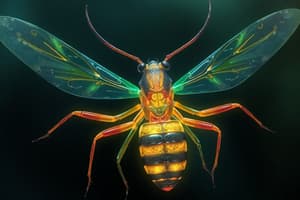Podcast
Questions and Answers
Which of the following is an example of metamorphosis?
Which of the following is an example of metamorphosis?
- Fish hatching from eggs
- Plants growing from seeds
- Birds changing into mammals
- Tadpoles changing into frogs (correct)
What is the typical outcome of metamorphosis?
What is the typical outcome of metamorphosis?
- No visible changes
- Gradual and subtle changes
- Permanent stasis
- Rapid and acute changes (correct)
Which life stage comes after the larva stage in metamorphosis?
Which life stage comes after the larva stage in metamorphosis?
- Adult
- Egg
- Pupa (correct)
- Adolescent
What is an exemption to the complete cycle of metamorphosis mentioned in the text?
What is an exemption to the complete cycle of metamorphosis mentioned in the text?
Which of the following animals does not undergo metamorphosis?
Which of the following animals does not undergo metamorphosis?
Which type of metamorphosis is characterized by the stages: egg, nymph, and adult?
Which type of metamorphosis is characterized by the stages: egg, nymph, and adult?
Which type of metamorphosis is also known as complete metamorphosis?
Which type of metamorphosis is also known as complete metamorphosis?
What is a disadvantage of complete metamorphosis?
What is a disadvantage of complete metamorphosis?
Which insect undergoes incomplete metamorphosis?
Which insect undergoes incomplete metamorphosis?
What distinguishes hypermetamorphosis from other types of metamorphosis?
What distinguishes hypermetamorphosis from other types of metamorphosis?
Flashcards
Metamorphosis
Metamorphosis
The process of transformation from an immature to a mature form in certain animals. It involves significant changes in body structure and function.
Typical outcome of metamorphosis
Typical outcome of metamorphosis
A rapid and significant change in an organism's body structure, often involving molting and complete reorganization of tissues.
Pupa stage
Pupa stage
The stage in complete metamorphosis where an insect is in a resting, inactive state, enclosed within a hardened cocoon or chrysalis.
Humans do not undergo metamorphosis
Humans do not undergo metamorphosis
Signup and view all the flashcards
Hemimetabolous metamorphosis
Hemimetabolous metamorphosis
Signup and view all the flashcards
Holometabolous metamorphosis
Holometabolous metamorphosis
Signup and view all the flashcards
Short lifespan of adults
Short lifespan of adults
Signup and view all the flashcards
Incomplete metamorphosis
Incomplete metamorphosis
Signup and view all the flashcards
Hypermetamorphosis
Hypermetamorphosis
Signup and view all the flashcards
Study Notes
Metamorphosis Examples and Characteristics
- An example of metamorphosis is the transformation from a caterpillar to a butterfly.
- The typical outcome of metamorphosis is the formation of a fully developed adult with distinct physical characteristics.
Stages of Metamorphosis
- In complete metamorphosis, the life stage that comes after the larva stage is the pupa stage.
- In incomplete metamorphosis, the life stage that comes after the larva stage is the adult stage.
Exceptions to Metamorphosis
- An exemption to the complete cycle of metamorphosis is the development of some species of fish, which undergo a gradual transformation from juvenile to adult.
Types of Metamorphosis
- Hemimetabolism is characterized by the stages: egg, nymph, and adult.
- Holometabolism is also known as complete metamorphosis, characterized by distinct larval and pupal stages.
Complete Metamorphosis Disadvantages
- A disadvantage of complete metamorphosis is the vulnerability of the pupa stage to predators and environmental factors.
Incomplete Metamorphosis Examples
- Grasshoppers undergo incomplete metamorphosis, with distinct juvenile stages (nymphs) that resemble small adults.
Hypermetamorphosis Characteristics
- Hypermetamorphosis is distinguished from other types of metamorphosis by the presence of multiple, distinct larval stages, each adapted to a specific environment.
Studying That Suits You
Use AI to generate personalized quizzes and flashcards to suit your learning preferences.




